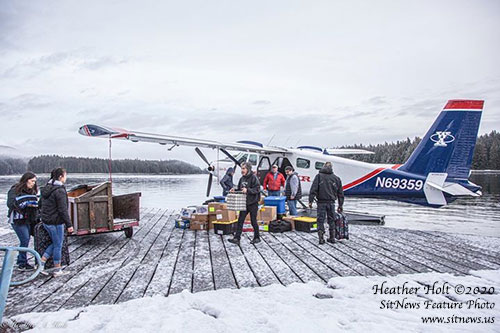NEWS ANALYSIS Marine Highway facing rough watersCosts spiral as the state reduces funding leading to layups and service cutbacksBy DAVE KIFFER
February 10, 2020
Four of the remaining 12 ships in the system are in semi-permanent layup and are unlikely to ever be deployed by the system again. At best, they could be sold, at worst they could end up being scrapped like the Taku, one of the original three "Blue Canoes" to join the fleet in 1963. The two fast ferries, the Fairweather and the Chenega, will never go back into service. The mainliner Malaspina and the smaller Aurora both require "expensive" hull refits that the state says it can't pay for and neither is likely to sail Alaskan waters again. Even that, though, is subject to debate. Which is a better - or a more likely - use of state funds? Around $16 million to repair the Malaspina or upwards of $200 million to replace it? The AHMS is already removing fixtures from the Malaspina so the state has clearly made the decision to surplus it.
Meanwhile, the last of the remaining original "blue canoes," the Matanuska just came back into service after a two-year refit and immediately suffered a major breakdown of its reduction gears and is now out of service at least for the next several weeks. For the first time since the early 1960s, there is no mainline state of Alaska ferry in service. The only AMHS vessel operating this month is the shuttle ferry Lituya going between Ketchikan and Metlakatla. Even the smaller feeder ferries - the LeConte and the Aurora - that usually operate between the smaller communities in Southeast and Prince William Sound, are out of the service. A new Alaska Class ferry, the Tazlina, is expected to go into service between Juneau and Haines and Skagway sometime in March. The Columbia, the Kennicott and the Tustemena are all on scheduled layup, meaning they are out of service until traffic increases in the spring and the summer. The future use of the brand new Alaska Class ferries, the Tazlina and the Hubbard, is uncertain. The ships were originally built to service Lynn Canal from Juneau, but larger than expected repair/renovation bills for the LeConte and the Aurora have put those ships futures into question and the state is considering replacing the older ships with the newer ones on those runs.
Unfortunately, the Alaska Class ships were built without crew quarters making them unusable on some of the longer runs. The newer ships would also require expensive modifications to be able to use docks other than the ones in Haines and Skagway. The state is even considering building a new ferry terminal in Berners Bay, 30 miles north of Juneau to shorten the Lynn Canal run. Areas that have long been a part of the service, such as Prince Rupert, British Columbia, have seen service temporarily ended. Under the proposed summer of 2020 schedule, Prince Rupert will get every other week service, but towns like Tenakee Springs and Pelican which have had service for many years are now out of the loop. As is Angoon. The State of Alaska recently commissioned a report to address structural changes in the system. One of the questions the report asked was whether or not the state could find a private company to operate the fleet with a state subsidy of $25 million or less - roughly a quarter of what the state has traditionally spent to operate the system. The answer - to the state's disappointment - was a resounding "no." Other options are also being considered, such as forming a public corporation to operate the ferries similar to how the Alaska Railroad operates. Once again, if the state is only willing to put in $25 million the answer is "no" unless you cut out the unprofitable runs. Which would be every run except Juneau to Lynn Canal and Ketchikan to Metlakatla. Meanwhile, prices continue to rise at the same time that service is being cut back. The system has instituted a flexible pricing system which raises rates based on popularity of the run and how close to sailing the tickets are purchased. Raising rates on runs which compete with air service is problematic because in more than a few cases it is actually cheaper to fly than to take the ferry. The result is that ridership has continued to drop and is now half of what it was a decade ago. It's hard to see that as anything other than a death spiral. The governor and the Legislature will have to decide what the next step is in terms of long term structural changes. The FY 20 budget featured a $40 million cut in the state operating subsidy. Communities that receive AMHS have been told to expect another cut in FY 21. But what that amount is, is unknown. State Legislators have said they support the system and want to restore service to traditional levels as well as take care of the maintenance needs to get as many ships as possible back into action. But as of now the only thing the Legislature has done is agree to cuts to the system that are not quite as deep as proposed by Governor Dunleavy. Meanwhile, the ferry system has put out a tentative summer schedule that shows service to Prince Rupert returning, every other week. There is no guarantee that the next winter schedule will continue that service. Issues such as Canadian police staffing of the terminal and whether to spend several million dollars to make necessary repairs to the nearly 60-year-old facility remain unresolved. The tentative Summer 2020 also shows the Kennicott operating between Bellingham and Kodiak. The Columbia will be on the Bellingham to Skagway run, the Matanuska on the Prince Rupert to Southeast run and the Tazlina running to Lynn Canal and occasionally to Gustavus. The Tustumena - which has been scheduled to be replaced for the past decade - also covers Southwest Alaska and two Aleutian Chain runs. The LeConte is expected to service Cordova, Valdez and Whittier much of the summer. This winter, Cordova, Valdez and Whittier have been completely without service most of the time, as has Kodiak. The proposed summer schedule represents a reduction over previous summer schedules but at least represents a relative "normalcy" of service. Unfortunately, communities looking ahead to next winter have no such assurance that they won't see loss of service similar to the current winter. Communities that face less or no service are scrambling to find alternatives to get supplies and provide access for their residents. Of course, the rough seas that the AMHS finds itself in are not a sudden occurrence. Nearly twenty years ago, the state went ahead with two expensive fast ferries at the same time that our neighbors in British Columbia were abandoning their fast ferry service because it was proving expensive, unreliable and inefficient. Then in the 2000s, the Marine Highway embarked on plans to develop a road system in Southeast that would eliminate mainline ferries by creating shorter feeder ferry runs. Those billion dollar roads were never built, but while the planning went on, significant maintenance issues in the larger ferries were deferred. Most recently, the state decided several years ago to not build a new full-service ferry but instead make the Alaska Class ferries more like shuttle ferries. Now that it appears they will be needed for more complex duties, expensive refits are almost a certainty. Compounding the issue is a clear signal from the state government that legislators in the Rail Belt and elsewhere are not interested in continuing the subsidies that have always been needed to operate the system. And uncertainty in the system, as well as the long ship layups, have caused a significant crew drain for the system. It is becoming harder and harder to find enough crew members who are only interested in working the summer season and not year-round. At the same time, the state government has made little secret of its desire to role back ferry worker wages and benefits and to limit the current power of the ferry crew unions. In the recent study of the system, the consultant - Northern Economics (pdf) - made it clear that it believed salary and benefit reductions were essential to putting the AMHS on a more secure financial footing. Ferry workers naturally disagree with that conclusion. Cuirrently, Governor Dunleavy is attempting to put together an "Alaska Marine Highway Reshaping Group" that will reportedly include government officials, state legislators and some members of the public. The only question is if there are enough life boats remaining in the system if that effort founders.
On the Web:
Edited By Mary Kauffman, SitNews
|
|||||||



